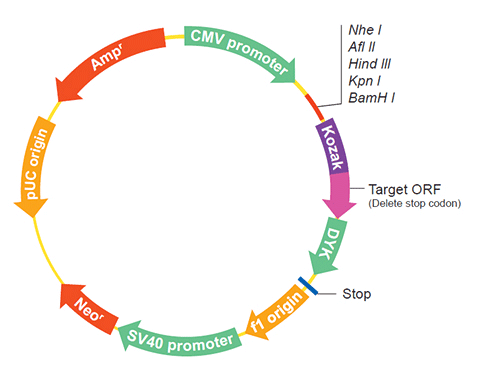| Gene Symbol | ADCYAP1 |
| Entrez Gene ID | 443337 |
| Full Name | adenylate cyclase activating polypeptide 1 |
| Synonyms | PACAP |
| Gene Type | protein-coding |
| Organism | Ovis aries(sheep) |
HOME
ORF » Species Summary » Ovis aries » ADCYAP1 cDNA ORF clone
| Gene Symbol | ADCYAP1 |
| Entrez Gene ID | 443337 |
| Full Name | adenylate cyclase activating polypeptide 1 |
| Synonyms | PACAP |
| Gene Type | protein-coding |
| Organism | Ovis aries(sheep) |
| mRNA | Protein | Name |
|---|---|---|
| NM_001009776.1 | NP_001009776.1 | pituitary adenylate cyclase-activating polypeptide precursor |


Transcriptomics and proteomics analyses of the PACAP38 influenced ischemic brain in permanent middle cerebral artery occlusion model mice.
Hori M, Nakamachi T, Rakwal R, Shibato J, Ogawa T, Aiuchi T, Tsuruyama T, Tamaki K, Shioda S
Journal of neuroinflammation9256(2012 Nov)
Pituitary adenylate cyclase-activating polypeptide (PACAP) and vasoactive intestinal peptide (VIP) regulate murine neural progenitor cell survival, proliferation, and differentiation.
Scharf E, May V, Braas KM, Shutz KC, Mao-Draayer Y
Journal of molecular neuroscience : MN36(1-3)79-88(2008 Nov)
PACAP and its receptor VPAC1 regulate megakaryocyte maturation: therapeutic implications.
Freson K, Peeters K, De Vos R, Wittevrongel C, Thys C, Hoylaerts MF, Vermylen J, Van Geet C
Blood111(4)1885-93(2008 Feb)
Isolation of a neuropeptide corresponding to the N-terminal 27 residues of the pituitary adenylate cyclase activating polypeptide with 38 residues (PACAP38).
Miyata A, Jiang L, Dahl RD, Kitada C, Kubo K, Fujino M, Minamino N, Arimura A
Biochemical and biophysical research communications170(2)643-8(1990 Jul)
A novel peptide which stimulates adenylate cyclase: molecular cloning and characterization of the ovine and human cDNAs.
Kimura C, Ohkubo S, Ogi K, Hosoya M, Itoh Y, Onda H, Miyata A, Jiang L, Dahl RR, Stibbs HH
Biochemical and biophysical research communications166(1)81-9(1990 Jan)
GeneRIFs: Gene References Into Functions What's a GeneRIF?
This study provided a detailed inventory of PACAP influenced gene expressions and protein targets in mice ischemic brain.
Title: Transcriptomics and proteomics analyses of the PACAP38 influenced ischemic brain in permanent middle cerebral artery occlusion model mice.
Results demonstrate that PACAP/VIP signaling is trophic and can maintain neural stem/progenitor cells in a multipotent state.
Title: Pituitary adenylate cyclase-activating polypeptide (PACAP) and vasoactive intestinal peptide (VIP) regulate murine neural progenitor cell survival, proliferation, and differentiation.
2 patients with trisomy 18p with PACAP overexpression and transgenic mice overexpressing PACAP in megakaryocytes have thrombopathy, a mild thrombocytopenia, and a reduced number of mature megakaryocytes in their bone marrow
Title: PACAP and its receptor VPAC1 regulate megakaryocyte maturation: therapeutic implications.
The following ADCYAP1 gene cDNA ORF clone sequences were retrieved from the NCBI Reference Sequence Database (RefSeq). These sequences represent the protein coding region of the ADCYAP1 cDNA ORF which is encoded by the open reading frame (ORF) sequence. ORF sequences can be delivered in our standard vector, pcDNA3.1+/C-(K)DYK or the vector of your choice as an expression/transfection-ready ORF clone. Not the clone you want? Click here to find your clone.
| CloneID | OSm00013 | |
| Clone ID Related Accession (Same CDS sequence) | NM_001009776.1 | |
| Accession Version | NM_001009776.1 Latest version! | Documents for ORF clone product in default vector |
| Sequence Information | ORF Nucleotide Sequence (Length: 531bp) Protein sequence SNP |
|
| Vector | pcDNA3.1-C-(k)DYK or customized vector |  User Manual User Manual |
| Clone information | Clone Map |  MSDS MSDS |
| Tag on pcDNA3.1+/C-(K)DYK | C terminal DYKDDDDK tags | |
| ORF Insert Method | CloneEZ™ Seamless cloning technology | |
| Insert Structure | linear | |
| Update Date | 2019-12-24 | |
| Organism | Ovis aries(sheep) | |
| Product | pituitary adenylate cyclase-activating polypeptide precursor | |
| Comment | Comment: PROVISIONAL REFSEQ: This record has not yet been subject to final NCBI review. The reference sequence was derived from S83511.1. ##Evidence-Data-START## Transcript exon combination :: S83511.1, GT642948.1 [ECO:0000332] ##Evidence-Data-END## | |
1 | ATGACCATGT GTAGCGGAGC GAGGCTGGCC CTGCTCGTTT ACGGGATACT GATGCACAGC |
The stop codons will be deleted if pcDNA3.1+/C-(K)DYK vector is selected.
| RefSeq | NP_001009776.1 |
| CDS | 577..1107 |
| Translation |

Target ORF information:
Target ORF information:
|
 NM_001009776.1 NM_001009776.1 |

1 | ATGACCATGT GTAGCGGAGC GAGGCTGGCC CTGCTCGTTT ACGGGATACT GATGCACAGC |
The stop codons will be deleted if pcDNA3.1+/C-(K)DYK vector is selected.
Transcriptomics and proteomics analyses of the PACAP38 influenced ischemic brain in permanent middle cerebral artery occlusion model mice. |
Pituitary adenylate cyclase-activating polypeptide (PACAP) and vasoactive intestinal peptide (VIP) regulate murine neural progenitor cell survival, proliferation, and differentiation. |
PACAP and its receptor VPAC1 regulate megakaryocyte maturation: therapeutic implications. |
Isolation of a neuropeptide corresponding to the N-terminal 27 residues of the pituitary adenylate cyclase activating polypeptide with 38 residues (PACAP38). |
A novel peptide which stimulates adenylate cyclase: molecular cloning and characterization of the ovine and human cDNAs. |